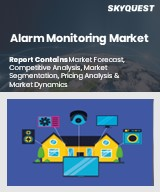
|
시장보고서
상품코드
1764769
알람 모니터링 시장 규모, 점유율, 성장 분석 : 제공 제품별, 입력 신호별, 통신기술별, 용도별, 지역별 - 산업 예측(2025-2032년)Alarm Monitoring Market Size, Share, and Growth Analysis, By Offering (Systems & Hardware, Software, Services, & Solutions), By Input Signal (Analog, Discrete), By Communication Technology, By Application, By Region - Industry Forecast 2025-2032 |
||||||
알람 모니터링 세계 시장 규모는 2023년에 578억 달러, 2024년 612억 1,000만 달러에서 2032년에는 968억 3,000만 달러로 성장하고, 예측 기간(2025-2032년) CAGR은 5.9%를 나타낼 전망입니다.
세계 알람 모니터링 시장은 주거, 상업, 산업 각 분야에서 증가하는 보안 수요에 힘입어 꾸준한 성장세를 보이고 있습니다. 사물인터넷(IoT), 인공지능(AI), 클라우드 컴퓨팅 등의 발달로 경보 시스템의 성능이 향상되고 있으며, 특히 안전 규제와 스마트 인프라 개발이 우선시되는 북미 등 선진국에서는 채택이 증가하고 있습니다. 그러나 높은 설치 및 유지보수 비용은 개발도상국의 중소기업(SME)과 주택 고객에게는 걸림돌이 될 수 있습니다. 또한, 정보 프라이버시에 대한 우려와 사이버 공격에 대한 네트워크 시스템의 취약성이 보안에 대한 논의를 복잡하게 만들고 있습니다. 다양한 규제에 대한 대응과 표준화의 필요성은 시장의 지속적인 성장에 여전히 중요한 장애물입니다.
목차
서론
- 조사 목적
- 조사 범위
- 정의
조사 방법
- 정보 조달
- 2차와 1차 데이터 방법
- 시장 규모 예측
- 시장 전제조건과 제한
주요 요약
- 세계 시장 전망
- 공급과 수요 동향 분석
- 부문별 기회 분석
시장 역학과 전망
- 시장 개요
- 시장 규모
- 시장 역학
- 성장 촉진요인과 기회
- 성장 억제요인과 과제
- Porter의 Five Forces 분석
주요 시장 인사이트
- 중요 성공 요인
- 경쟁 정도
- 주요 투자 기회
- 시장 생태계
- 시장의 매력 지수(2024년)
- PESTEL 분석
- 거시경제 지표
- 밸류체인 분석
- 가격 분석
- 기술 분석
- 사례 연구
- 고객 구매 행동 분석
알람 모니터링 시장 규모 : 제공 제품별
- 시장 개요
- 시스템과 하드웨어
- 원격 터미널 유닛(RTUS)
- 알람 센서
- 모션 감지 센서
- 도어/창문 센서
- 화재/연기 감지 센서
- 통신 네트워크 및 게이트웨이
- 중앙 모니터링 수신기
- 기타
- 소프트웨어, 서비스 및 솔루션
- 모니터링 서비스
- 설치 서비스
- 소프트웨어
알람 모니터링 시장 규모 : 입력 신호별
- 시장 개요
- 아날로그
- 디스크리트
- 프로토콜
알람 모니터링 시장 규모 : 통신 기술별
- 시장 개요
- 유선 통신 네트워크
- 셀룰러 무선 네트워크
- 무선 네트워크
- IP 네트워크
알람 모니터링 시장 규모 : 용도별
- 시장 개요
- 건물 알람 모니터링
- 기기 모니터링
- 통신 기기
- 산업 기기 감시
- 의료기기 모니터링
- 기타
- 차량 알람 모니터링
- 환경 모니터링
알람 모니터링 시장 규모
- 북미
- 미국
- 캐나다
- 유럽
- 독일
- 스페인
- 프랑스
- 영국
- 이탈리아
- 기타 유럽
- 아시아태평양
- 중국
- 인도
- 일본
- 한국
- 기타 아시아태평양
- 라틴아메리카
- 브라질
- 기타 라틴아메리카
- 중동 및 아프리카
- GCC 국가
- 남아프리카공화국
- 기타 중동 및 아프리카
경쟁 정보
- 주요 5개사 비교
- 주요 기업의 시장 포지셔닝(2024년)
- 주요 시장 기업이 채택한 전략
- 최근 시장 동향
- 기업의 시장 점유율 분석(2024년)
- 주요 기업 개요
- 기업 상세
- 제품 포트폴리오 분석
- 기업 부문별 점유율 분석
- 매출 전년대비 비교(2022-2024년)
주요 기업 개요
- ABB Ltd.
- Siemens AG
- Rockwell Automation Inc.
- Honeywell International Inc.
- Schneider Electric SE
- ADT Corporation
- Diebold Nixdorf
- Johnson Controls International Plc
- CPI Security System Inc.
- Samsung Electronics Co Ltd.
- Securitas
결론과 제안
LSH 25.07.16Global Alarm Monitoring Market size was valued at USD 57.8 billion in 2023 and is poised to grow from USD 61.21 billion in 2024 to USD 96.83 billion by 2032, growing at a CAGR of 5.9% during the forecast period (2025-2032).
The global alarm monitoring market is witnessing steady growth, fueled by escalating security demands across residential, commercial, and industrial sectors. Innovations such as the Internet of Things (IoT), artificial intelligence (AI), and cloud computing are enhancing alarm system performance, leading to increased adoption, particularly in advanced economies like North America, where safety regulations and smart infrastructure development are prioritized. However, challenges such as high installation and maintenance costs could hinder small and medium businesses (SMEs) and residential customers in developing regions. Additionally, concerns about information privacy and the vulnerability of networked systems to cyber-attacks complicate security discussions. Compliance with diverse regulations and the need for standardization remain crucial hurdles for sustained market growth.
Top-down and bottom-up approaches were used to estimate and validate the size of the Global Alarm Monitoring market and to estimate the size of various other dependent submarkets. The research methodology used to estimate the market size includes the following details: The key players in the market were identified through secondary research, and their market shares in the respective regions were determined through primary and secondary research. This entire procedure includes the study of the annual and financial reports of the top market players and extensive interviews for key insights from industry leaders such as CEOs, VPs, directors, and marketing executives. All percentage shares split, and breakdowns were determined using secondary sources and verified through Primary sources. All possible parameters that affect the markets covered in this research study have been accounted for, viewed in extensive detail, verified through primary research, and analyzed to get the final quantitative and qualitative data.
Global Alarm Monitoring Market Segments Analysis
Global Alarm Monitoring Market is segmented by Offering, Input Signal, Communication Technology, Application and region. Based on Offering, the market is segmented into Systems & Hardware and Software, Services, & Solutions. Based on Input Signal, the market is segmented into Analog, Discrete and Protocol. Based on Communication Technology, the market is segmented into Wired Telecommunication Network, Cellular Wireless Network and Wireless Radio Network. Based on Application, the market is segmented into Building Alarm Monitoring, Equipment Monitoring, Vehicle Alarm Monitoring and Environmental Monitoring. Based on region, the market is segmented into North America, Europe, Asia Pacific, Latin America and Middle East & Africa.
Driver of the Global Alarm Monitoring Market
The Alarm Monitoring Market is primarily driven by the escalating demand for immediate and dependable threat detection across various sectors, including residential, commercial, and industrial. Factors such as rapid urbanization, rising crime rates, and heightened concerns regarding workplace and public safety have compelled both organizations and individuals to embrace real-time monitoring and automated emergency response systems. Central monitoring stations, bolstered by cloud technology and interconnected sensors, enable quicker alerts and coordinated actions. This transition towards proactive security measures, as opposed to reactive ones, is significantly enhancing market penetration and fostering the development of smart infrastructure projects on a global scale.
Restraints in the Global Alarm Monitoring Market
A significant challenge hindering the adoption of advanced alarm monitoring systems is the steep initial installation costs, coupled with ongoing maintenance and subscription expenses. For budget-conscious households and small businesses, the financial burden of hardware, wiring, control panels, and service plans can be excessively high. Additionally, the need for professional-grade installation adds to the overall expense, further discouraging potential users. These financial barriers are particularly impactful in emerging markets and among low-income groups, ultimately restricting broader access and limiting the potential for inclusive growth within the global alarm monitoring market.
Market Trends of the Global Alarm Monitoring Market
The Global Alarm Monitoring market is experiencing a significant trend towards the integration of AI-powered technologies for enhanced threat detection and incident management. As organizations seek to streamline their security operations, AI-driven algorithms are being implemented to distinguish between false alarms and genuine threats by analyzing data from various sources, such as motion sensors and surveillance feeds. This advancement not only improves the accuracy of response efforts but also reduces operational costs for businesses by minimizing disruptions. Consequently, the growing reliance on sophisticated monitoring solutions fosters greater consumer confidence, driving demand and solidifying the market's trajectory towards smarter security systems.
Table of Contents
Introduction
- Objectives of the Study
- Scope of the Report
- Definitions
Research Methodology
- Information Procurement
- Secondary & Primary Data Methods
- Market Size Estimation
- Market Assumptions & Limitations
Executive Summary
- Global Market Outlook
- Supply & Demand Trend Analysis
- Segmental Opportunity Analysis
Market Dynamics & Outlook
- Market Overview
- Market Size
- Market Dynamics
- Drivers & Opportunities
- Restraints & Challenges
- Porters Analysis
- Competitive rivalry
- Threat of substitute
- Bargaining power of buyers
- Threat of new entrants
- Bargaining power of suppliers
Key Market Insights
- Key Success Factors
- Degree of Competition
- Top Investment Pockets
- Market Ecosystem
- Market Attractiveness Index, 2024
- PESTEL Analysis
- Macro-Economic Indicators
- Value Chain Analysis
- Pricing Analysis
- Technology Analysis
- Case Studies
- Customer Buying Behavior Analysis
Global Alarm Monitoring Market Size by Offering & CAGR (2025-2032)
- Market Overview
- Systems & Hardware
- Remote Terminal Units (RTUS)
- Alarms Sensors
- Motion Detector Sensors
- Door/Window Sensors
- Fire/Smoke Detecting Sensors
- Communication Networks & Gateways
- Central Monitoring Receivers
- Others
- Software, Services, & Solutions
- Monitoring Services
- Installation Services
- Software
Global Alarm Monitoring Market Size by Input Signal & CAGR (2025-2032)
- Market Overview
- Analog
- Discrete
- Protocol
Global Alarm Monitoring Market Size by Communication Technology & CAGR (2025-2032)
- Market Overview
- Wired Telecommunication Network
- Cellular Wireless Network
- Wireless Radio Network
- IP Network
Global Alarm Monitoring Market Size by Application & CAGR (2025-2032)
- Market Overview
- Building Alarm Monitoring
- Equipment Monitoring
- Telecom Equipment
- Industrial Equipment Monitoring
- Medical Equipment Monitoring
- Others
- Vehicle Alarm Monitoring
- Environmental Monitoring
Global Alarm Monitoring Market Size & CAGR (2025-2032)
- North America (Offering, Input Signal, Communication Technology, Application)
- US
- Canada
- Europe (Offering, Input Signal, Communication Technology, Application)
- Germany
- Spain
- France
- UK
- Italy
- Rest of Europe
- Asia Pacific (Offering, Input Signal, Communication Technology, Application)
- China
- India
- Japan
- South Korea
- Rest of Asia-Pacific
- Latin America (Offering, Input Signal, Communication Technology, Application)
- Brazil
- Rest of Latin America
- Middle East & Africa (Offering, Input Signal, Communication Technology, Application)
- GCC Countries
- South Africa
- Rest of Middle East & Africa
Competitive Intelligence
- Top 5 Player Comparison
- Market Positioning of Key Players, 2024
- Strategies Adopted by Key Market Players
- Recent Developments in the Market
- Company Market Share Analysis, 2024
- Company Profiles of All Key Players
- Company Details
- Product Portfolio Analysis
- Company's Segmental Share Analysis
- Revenue Y-O-Y Comparison (2022-2024)
Key Company Profiles
- ABB Ltd.
- Company Overview
- Business Segment Overview
- Financial Updates
- Key Developments
- Siemens AG
- Company Overview
- Business Segment Overview
- Financial Updates
- Key Developments
- Rockwell Automation Inc.
- Company Overview
- Business Segment Overview
- Financial Updates
- Key Developments
- Honeywell International Inc.
- Company Overview
- Business Segment Overview
- Financial Updates
- Key Developments
- Schneider Electric SE
- Company Overview
- Business Segment Overview
- Financial Updates
- Key Developments
- ADT Corporation
- Company Overview
- Business Segment Overview
- Financial Updates
- Key Developments
- Diebold Nixdorf
- Company Overview
- Business Segment Overview
- Financial Updates
- Key Developments
- Johnson Controls International Plc
- Company Overview
- Business Segment Overview
- Financial Updates
- Key Developments
- CPI Security System Inc.
- Company Overview
- Business Segment Overview
- Financial Updates
- Key Developments
- Samsung Electronics Co Ltd.
- Company Overview
- Business Segment Overview
- Financial Updates
- Key Developments
- Securitas
- Company Overview
- Business Segment Overview
- Financial Updates
- Key Developments












